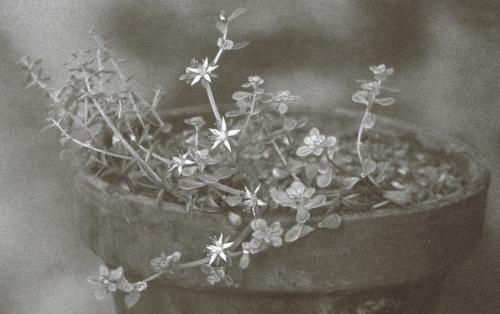Ray Stephenson : Sedum rosulatobulbosum Koidzumi (1938) & Sedum bulbiferum Makino (1891)
Common names : Korai-ko-mochi-mannengusa; Ko-mochi-mannengusa.
Sedum bulbiferum has been included with S. alfredi and S. lineare in the past, but together with S. rosulatobulbosum it is unique in disintegrating and casting a multitude of adventitious buds or bulbils to the wind. Uhl and Moran do not differentiate between these two species for cytologically as well as vegetatively they have much in common. Dwellers of heavily shaded valleys in damp places, even on rocks in the middle of mountain rivulets, these oddities need special cultivation.
Stems rise to as much as 20 cm (8 in) high before flowering, producing copious quantities of bulbils, and then collapsing. In my experience, Sedum rosulatobulbosum is the most robust species with large adventitious bulbils, consisting of rosettes of almost-round leaves more than 1 cm (0,4 in) across. In addition, the species tends to be perennial with the main plant regenerating in spring.
Sedum bulbiferum is much smaller, with narrower leaves and tiny bulbils consisting of only a couple of pairs of opposite-decussate leaves. It tends to be annual or biennial. Makino says that in the wild all parent plants perish and that together these stonecrops are the most common in Japan. He says that only sterile seed is produced.

Sedum rosulatobulbosum in a 5-in (13-cm) terra-cotta pot.
Habitat : Sedum rosulatobulbosum is said to be Korean and from Hachijo Island in Izu Province of Japan, while S. bulbiferum is indigenous to Honshu, Shikoku, and Kyushu islands, Japan.
Main points of distinction : Plants are very similar to Sedum subtile, but the development of bulbils is unique to S. rosulatobulbosum and S. bulbiferum. In addition, stems of these species are very unusual for the genus as they are grooved in the upper part until they are almost square or hexagonal in section. Leaves are spurred. Lax, branched inflorescences carry flowers with unequal, free, spurred sepals, ephemeral petals, and somewhat divergent carpels.
Variation : Perhaps intermediate forms exist. Uhl and Moran show that both Korean and Japanese plants have n = 19 and that triploids exist in the wild.
Horticulture : Fascinating perhaps, but these oddities are somewhat of an anathema to growers of xerophites or alpines. Perhaps the plants would benefit from being grown in a water garden or beside an artificial waterfall. I have never managed to perpetuate the minor of the two forms for more than consecutive seasons. Shade and damp conditions are essential, but plants soon rot if overwintered in an unventilated, damp environment.
Ray Stephenson (Sedum, Cultivated Stonecrops, 1994, pp 166 - 168)